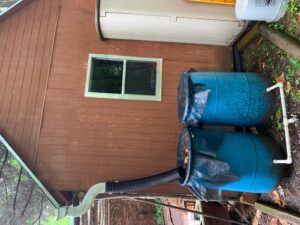Collecting Rainwater at Home
go.ncsu.edu/readext?806032
en Español / em Português
El inglés es el idioma de control de esta página. En la medida en que haya algún conflicto entre la traducción al inglés y la traducción, el inglés prevalece.
Al hacer clic en el enlace de traducción se activa un servicio de traducción gratuito para convertir la página al español. Al igual que con cualquier traducción por Internet, la conversión no es sensible al contexto y puede que no traduzca el texto en su significado original. NC State Extension no garantiza la exactitud del texto traducido. Por favor, tenga en cuenta que algunas aplicaciones y/o servicios pueden no funcionar como se espera cuando se traducen.
Português
Inglês é o idioma de controle desta página. Na medida que haja algum conflito entre o texto original em Inglês e a tradução, o Inglês prevalece.
Ao clicar no link de tradução, um serviço gratuito de tradução será ativado para converter a página para o Português. Como em qualquer tradução pela internet, a conversão não é sensivel ao contexto e pode não ocorrer a tradução para o significado orginal. O serviço de Extensão da Carolina do Norte (NC State Extension) não garante a exatidão do texto traduzido. Por favor, observe que algumas funções ou serviços podem não funcionar como esperado após a tradução.
English
English is the controlling language of this page. To the extent there is any conflict between the English text and the translation, English controls.
Clicking on the translation link activates a free translation service to convert the page to Spanish. As with any Internet translation, the conversion is not context-sensitive and may not translate the text to its original meaning. NC State Extension does not guarantee the accuracy of the translated text. Please note that some applications and/or services may not function as expected when translated.
Collapse ▲The rainy summers of the past few years helped gardeners in Henderson County forget that we need to irrigate our gardens. In 2021, the summer has turned out drier and some of us have let our recently planted trees, shrubs and flowers get a little too dry. It is time to start thinking about how we irrigate our plants.
It is not always wet in western North Carolina. A severe drought in 2007 and 2008 that led to wildfires got people thinking about the options for alternative water sources. Most homeowners use treated drinking water (city water) to satisfy all of their water needs.

These rain barrels are connected to a gutter on a garden shed. The barrels are connected so that both fill during rain events and can be drained to use as irrigation water.
During droughts this type of water can be replaced by captured rainwater. For example, harvested rainwater can be used for watering gardens, washing vehicles, and flushing toilets. With special treatment and plumbing, it is even possible for harvested rainwater to become the primary water supply for a home or business.
A rainwater harvesting system captures stormwater runoff, usually from a rooftop, and stores that water for later use. Using harvested rainwater for purposes that don’t require treated drinking water has many advantages:
- It reduces the demand on municipal water supplies and thus increases the sustainability of drinking water supplies.
- Its use may be exempt from restrictions during a drought.
- It can reduce water bills, meaning the system can partially pay for itself.
- It can improve the environment by capturing nutrients and other pollutants from rooftop runoff, preventing them from contaminating surface waters.
It can contribute valuable plant nutrients, such as nitrogen and phosphorus, to garden irrigation water.
Would you like to learn more about harvesting rainwater at your home? Then check out our NC State publication on Rainwater Harvesting at Home.




